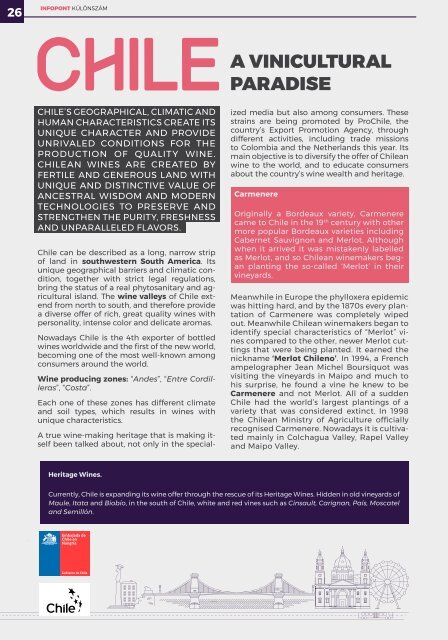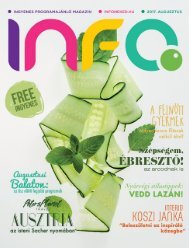Budapest Borfesztivál InfoPont különszám
Kiállítók, programok, érdekességek a bor világából
Kiállítók, programok, érdekességek a bor világából
Create successful ePaper yourself
Turn your PDF publications into a flip-book with our unique Google optimized e-Paper software.
26<br />
INFOPONT KÜLÖNSZÁM<br />
CHILE<br />
A VINICULTURAL<br />
PARADISE<br />
CHILE’S GEOGRAPHICAL, CLIMATIC AND<br />
HUMAN CHARACTERISTICS CREATE ITS<br />
UNIQUE CHARACTER AND PROVIDE<br />
UNRIVALED CONDITIONS FOR THE<br />
PRODUCTION OF QUALITY WINE.<br />
CHILEAN WINES ARE CREATED BY<br />
FERTILE AND GENEROUS LAND WITH<br />
UNIQUE AND DISTINCTIVE VALUE OF<br />
ANCESTRAL WISDOM AND MODERN<br />
TECHNOLOGIES TO PRESERVE AND<br />
STRENGTHEN THE PURITY, FRESHNESS<br />
AND UNPARALLELED FLAVORS.<br />
Chile can be described as a long, narrow strip<br />
of land in southwestern South America. Its<br />
unique geographical barriers and climatic condition,<br />
together with strict legal regulations,<br />
bring the status of a real phytosanitary and agricultural<br />
island. The wine valleys of Chile extend<br />
from north to south, and therefore provide<br />
a diverse offer of rich, great quality wines with<br />
personality, intense color and delicate aromas.<br />
Nowadays Chile is the 4th exporter of bottled<br />
wines worldwide and the first of the new world,<br />
becoming one of the most well-known among<br />
consumers around the world.<br />
Wine producing zones: “Andes”, “Entre Cordilleras”,<br />
“Costa”.<br />
Each one of these zones has different climate<br />
and soil types, which results in wines with<br />
unique characteristics.<br />
A true wine-making heritage that is making itself<br />
been talked about, not only in the specialized<br />
media but also among consumers. These<br />
strains are being promoted by ProChile, the<br />
country’s Export Promotion Agency, through<br />
different activities, including trade missions<br />
to Colombia and the Netherlands this year. Its<br />
main objective is to diversify the offer of Chilean<br />
wine to the world, and to educate consumers<br />
about the country’s wine wealth and heritage.<br />
Carmenere<br />
Originally a Bordeaux variety, Carmenere<br />
came to Chile in the 19 th century with other<br />
more popular Bordeaux varieties including<br />
Cabernet Sauvignon and Merlot. Although<br />
when it arrived it was mistakenly labelled<br />
as Merlot, and so Chilean winemakers began<br />
planting the so-called ‘Merlot’ in their<br />
vineyards.<br />
Meanwhile in Europe the phylloxera epidemic<br />
was hitting hard, and by the 1870s every plantation<br />
of Carmenere was completely wiped<br />
out. Meanwhile Chilean winemakers began to<br />
identify special characteristics of “Merlot” vines<br />
compared to the other, newer Merlot cuttings<br />
that were being planted. It earned the<br />
nickname ‘Merlot Chileno’. In 1994, a French<br />
ampelographer Jean Michel Boursiquot was<br />
visiting the vineyards in Maipo and much to<br />
his surprise, he found a vine he knew to be<br />
Carmenere and not Merlot. All of a sudden<br />
Chile had the world’s largest plantings of a<br />
variety that was considered extinct. In 1998<br />
the Chilean Ministry of Agriculture officially<br />
recognised Carmenere. Nowadays it is cultivated<br />
mainly in Colchagua Valley, Rapel Valley<br />
and Maipo Valley.<br />
Heritage Wines.<br />
Currently, Chile is expanding its wine offer through the rescue of its Heritage Wines. Hidden in old vineyards of<br />
Maule, Itata and Biobío, in the south of Chile, white and red vines such as Cinsault, Carignan, País, Moscatel<br />
and Semillón.














